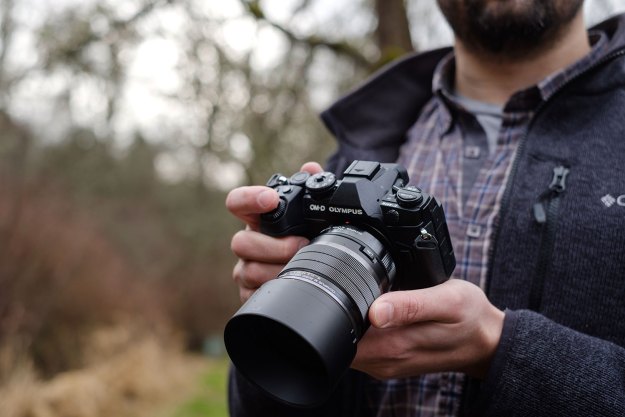
- Pleasing “feathered bokeh” effect
- f/1.2 maximum aperture
- Sharp, even wide open
- Weather-sealed
- AF/MF clutch
- Chromatic aberration at wide apertures
- Held back by MFT sensors
We have an odd tendency to develop emotional attachments to material objects. Even deeply flawed products can make us fall in love, often because of their quirks rather than in spite of them, while technically perfect things many times come off as cold or soulless. A brand new car may never inspire the same feeling of independence as that old clunker that gave you your first taste of real freedom at 16. Nor is typing up a story on a modern laptop’s chiclet keys anywhere near as satisfying as hammering out words on an old mechanical keyboard.
For photographers, this effect is particularly true. We tend to hold onto old cameras far past their usefulness, and often talk as much about the look and feel of a camera or lens as its actual capabilities. The $1,200 Olympus M.Zuiko 25mm F1.2 Pro, however, is a technically excellent lens that may also just be special enough to inspire you emotionally. It highlights the impressive move that the Micro Four Thirds system has made into the world of professional photography. And yet, it wasn’t made with just objective image quality in mind.
A technically excellent lens that may also be special enough to inspire you emotionally.
This year will mark the 10-year anniversary of the pioneering mirrorless camera format, and in that time, it has evolved into one of the most versatile camera systems ever made. But ten years ago, we would have never expected to see a $1,200 normal focal length lens for it. Professional photographers and advanced enthusiasts — the only two groups who could realistically be expected to drop that kind of money on such a lens — simply weren’t shooting mirrorless at the time. A decade later, and it would seem this has changed.
The 25mm F1.2 Pro also isn’t just an expensive one-off. It’s part of a series of high-end lenses, which also includes the 17mm F1.2 Pro and 45mm F1.2 Pro. They all carry the same price tag, but it’s the 25mm, with a full-frame equivalent focal length of 50mm, that yields the biggest sticker shock. 50mm lenses for full-frame cameras are widely available for less than $500 — some for much less — even with wider effective apertures. So is Olympus’ 25mm F1.2 Pro really that good? Yes, it is.
The circle of confusion
Before we get to the many merits of the 25mm F1.2 Pro, it’s worth taking a moment to establish expectations. Likely, photographers seriously considering this lens already understand what its specifications mean, but the numbers game can be confusing for less experienced shooters or those considering making the jump to MFT from another format.
MFT cameras and lenses are smaller than their DSLR counterparts partly due to their mirrorless design, but also thanks to a physically smaller image sensor. Four Thirds sensors have a 2x crop factor compared to full-frame, and while this is generally well understood as it applies to focal length — a 25mm MFT lens is equivalent to a 50mm full-frame lens — it also applies to aperture, a fact that is perhaps less well understood. So, an f/1.2 MFT lens is equivalent to an f/2.4 full-frame lens, both in terms of total light gathering ability and depth of field. (For a much more in-depth look at this, there is an excellent aperture equivalence explainer over at DPReview.)
Now, at the end of the day, what you see is what you get, so we don’t need to spend too much time on this topic. However, this is an important concept to understand in order to be an educated consumer, because when a company markets an f/1.2 lens, it can sound very special. It inspires many oohs and aahs in the bokeh lover inside all of us. But can you imagine Canon or Nikon marketing a 50mm f/2.4 lens? Unless it’s a specialized lens like a macro, or includes a free pizza, it wouldn’t really turn any heads. If you happen to be a full-frame Canon shooter and are interested in switching to MFT, but want a normal focal length lens that captures as shallow a depth of field as your $125 “nifty 50” f/1.8, you’re out of luck.
That’s not to say the Olympus 25mm F1.2 Pro is a rip-off, far from it. Rather, the point here is simply to understand what the numbers mean so you know what to expect. Depth of field may be a measurable quality of a lens that we all like to gloat over, but it is hardly the only aspect of a pleasing photograph.
Design and specifications
Delving into the optical construction of the 25mm Pro immediately reveals a staggering difference between this and other normal focal length lenses. It houses 19 elements in 14 groups, including all sorts of extra-low dispersion and high refractive index elements and one aspherical element. It may be the most complex arrangement we’ve ever seen for a lens with this field of view, and begins to explain the high price. The aforementioned Canon 50mm f/1.8 uses just six elements. Even the $4,000 Zeiss Otus 55mm f/1.4 — a very, very good lens — has just 12 elements in 10 groups.
The exterior of the lens is equally well made, with a dust and splash-proof design. It is considerably larger than the Olympus 25mm F1.8, making it well suited to our OM-D E-M1 Mark II test camera, but perhaps less so for smaller bodies. The focus ring can be pulled back to engage the manual focus clutch, which provides smooth focus control with physical stop points at the close-focus and infinity positions. The Lens Function (L.Fn) button near the mount opens up access to a wide variety of programmable functions, letting you quickly change a setting without removing your hands from shooting position. The included lens hood is plastic, but still has a premium feel. It locks securely into place and uses a release button to unlock.
Overall, this is one of the most premium feeling prime lenses we’ve tried on any camera system, and just proves that the f/1.2 aperture isn’t the only thing special about it. It provides a satisfying, tactile experience that will make you want an excuse to go shoot something just so you can use it. If you happen to have it sitting on your desk while you work, you’ll find yourself occasionally picking it up and handling it like an expensive fidget toy.
Image quality and feathered bokeh
When it comes to separating a subject from the background, there’s more to it than simply a shallow depth of field. Olympus’ goal with the F1.2 Pro series was to craft a specific quality of blur. The company calls the effect “feathered bokeh,” and the look is slightly reminiscent of lenses that use an apodization filter, such as the Fujifilm XF 56mm F1.2 R APD and Sony 100mm f/2.8 STM GM OSS.
It provides a tactile experience that will make you want an excuse to go shoot something just so you can use it.
Essentially, there are three types of bokeh, as defined by the look of the blur circle produced by a lens: ring, solid, and “feathered.” A feathered blur circle is softer, and tends be more natural looking and less distracting. Achieving this effect requires very precise design and manufacturing and is one reason why the 25mm F1.2 Pro has such a complex optical design. In fact, as Olympus demonstrated for us using its in-house lens simulation tool, moving the position of a single element by a mere 5 microns was enough to drastically alter the quality of bokeh, changing the blur circles from feathered to solid.
How much you notice the effect depends on how and what you shoot. At f/1.2, you can see it easily if you have any bright points in the background of your image. But Olympus also says this is what gives the F1.2 Pro series lenses their smooth focus falloff, something that is perhaps less noticeable but contributes more to the overall look of the image.
Shot wide open, the lens also produces a pleasing vignette that further helps separate subject and background while adding a soft, warm look to the image. This does mean this lens might be less effective in low light than you may be expecting. In dark situations, keep your subject near the center of the frame for the brightest exposure; anything near the edges will appear significantly darker. And while we rather liked the look of the vignette for portraits and product shots, if you prefer a more even exposure across the frame, it is fortunately all but gone by f/1.8.
Sharpness is generally excellent, although does improve as the aperture is stopped down to the middle of the range. As we also saw with the 17mm F1.2 Pro, some chromatic aberration in the form of purple fringing is present when shooting at wide apertures. In general, we only noticed this when photographing subjects on a bright background, such as tree branches against the sky. While chromatic aberration persisted on the 17mm even at f/4, it is all but imperceptible by f/2.8 on the 25mm.
It may be equivalent to just a full-frame 50mm f/2.4, but it’s a world away from any “nifty 50.”
Normal focal length lenses aren’t generally plagued by heavy amounts of distortion, but cheaper models do tend to have a noticeable amount of it. The 25mm F1.2 Pro, however, seems to produce no perceptible distortion, at least not to the degree that we could see it in the real world.
However, as good as this lens is, it is somewhat held back by the MFT format itself. The 20MP sensor in the OM-D E-M1 Mark II simply does not have the high resolution nor the low noise levels of larger sensors. While images look great overall, zooming in to 100 percent reveals a decent amount of noise, even at base ISO. Even without taking the lower pixel count into consideration, this limits the level of detail recorded compared to larger sensors.
This all means that while the 25mm F1.2 Pro is a fantastic lens when compared against other MFT offerings, we can’t definitively say it’s enough to draw in image-quality-conscious photographers from larger formats. Subjectively, however, it is one of the best normal focal length lenses we’ve tested; but the objective limitations of the format may bring some people pause.
Warranty
Olympus offers a one-year warranty on MFT cameras and lenses. A four-year extended warranty is available for $79.
Our Take
At $1,200, the M.Zuiko 25mm F1.2 Pro is considerably more expensive than other 25mm lenses for Micro Four Thirds. That makes it a tough sell for some, but photographers with the budget will undoubtedly find it worth it, particularly those working in challenging weather or terrain who need a durable, weather-sealed lens.
However, our favorite thing about it — indeed, about the entire F1.2 Pro series — is that Olympus has poured years of research and development into crafting an insanely complex optical design, all for the purpose of creating subjectively pleasing photographs. While its technical merits of sharpness, low distortion, and excellent build quality are commendable, the real victory is in the softness of the bokeh and the warmth of the vignette that invite your eyes into the image and encourage a closer look. It may be equivalent to just a full-frame 50mm f/2.4, but it’s a world away from any “nifty 50.”
Is there a better alternative?
For the budget-conscious photographer, the Olympus 25mm F1.8 is a fantastic lens in its own right, as is the Panasonic Leica 25mm f/1.4. Both are quite a bit more compact and less expensive than the 25mm F1.2 Pro, although they lack the advanced optical design and durable build quality.
For professionals and enthusiasts with the money to spend, however, the 25mm F1.2 Pro is the way to go.
How long will it last?
This lens is built exceptionally well and we expect it will easily outlive whatever camera you put it on. We don’t expect Olympus will release an updated version anytime soon, although it’s not outside the realm of possibility that Panasonic will produce its own 25mm f/1.2 lens for MFT cameras. We wouldn’t hold our breath, though, even if you’re a Panasonic shooter.
Should you buy it?
Yes. There simply isn’t a better choice for a normal focal length lens on the MFT system. Again, the price will limit its audience, but this is likely a must-have lens for pros and advanced amateurs. We may have some lingering complaints about MFT sensors, but lenses like this are pushing the format beyond where we ever imagined it would be.















